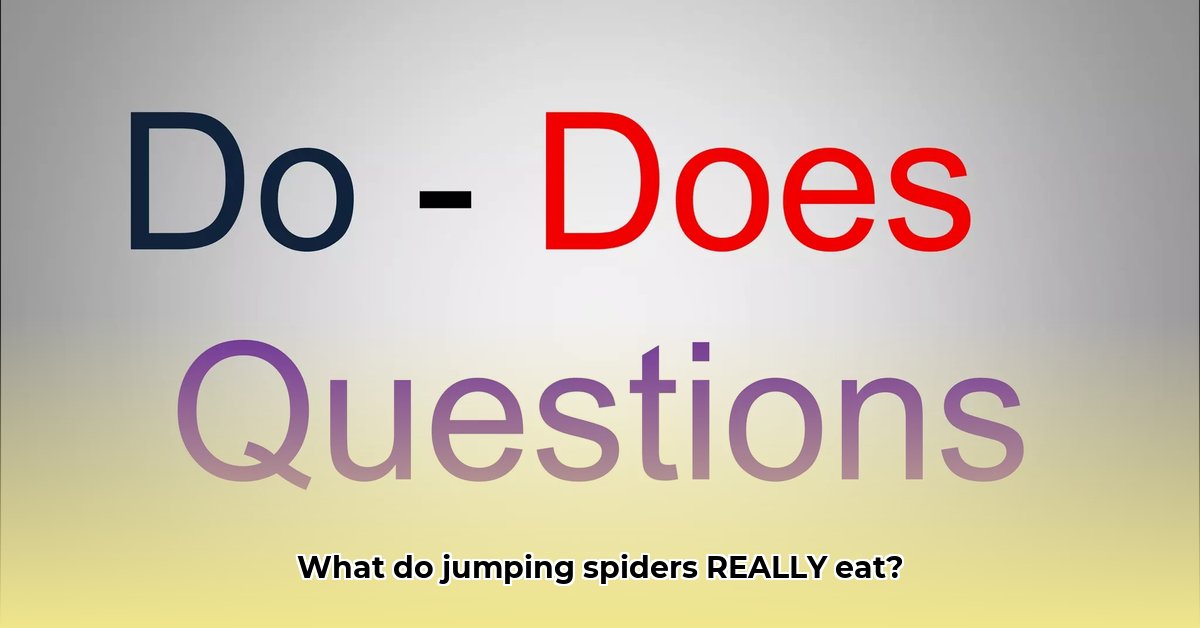So, you’ve got a new jumping spider – awesome! These tiny acrobats are amazing pets, but keeping them happy and healthy means knowing what they like to eat. This guide will walk you through everything you need to know about feeding your jumping spider, from choosing the right snacks to spotting signs that something’s wrong. We’ll cover what to feed them, how much, and how often – plus some helpful tips and tricks to make sure your spider lives a long and exciting life. Whether you’re a beginner or a seasoned spider owner, this guide will give you all the info you need to become the best jumping spider caregiver possible. Let’s get started!
What Do Jumping Spiders Eat?
So, what’s on the menu for your tiny, eight-legged friend? It’s more than just tossing in any bug you find! Feeding your jumping spider correctly is key to its happiness and long life. Let’s dive into the fascinating world of jumping spider nutrition. What are the ideal prey options for your pet?
The Jumping Spider’s Daily Bites: A Balanced Diet
The cornerstone of a jumping spider’s diet usually involves readily available insects. Crickets are a popular and easy choice, offering a good mix of nutrients. Remember to gut-load your crickets with nutritious food like fruits and vegetables before feeding them to your spider to further enhance their nutritional value. Flies are another excellent option; both tiny fruit flies (Drosophila melanogaster) and larger bluebottles (Calliphora vomitoria) are great food sources. You can even buy flightless fruit flies online or at pet stores to make feeding easier. Mealworms (Tenebrio molitor) add variety, but remember they’re higher in fat, so don’t overdo them; they should only make up a small portion of the overall diet. Even some types of roaches can be a good addition to their diet, such as Dubia roaches (Blaptica dubia), as long as they’re the right size and sourced from a reputable breeder to ensure they’re free from parasites and diseases – we’ll get to that important detail in a minute. Waxworms (Galleria mellonella) can also be offered as an occasional treat due to their high fat content. Choosing the right nutrient-rich insects is critical for spider health. For example, crickets are a good source of protein, while flies offer essential vitamins and minerals.
Getting the Size Just Right: A Goldilocks Approach
This is incredibly important: always match the prey’s size to your spider’s size. Think of it like this: a tiny spiderling needs a teeny-tiny fruit fly; a larger adult can handle a bigger cricket. A good rule of thumb is that the prey item should be no larger than the spider’s abdomen. If the prey is too large, it could hurt or even kill your spider, or the prey may not be eaten and could stress your spider. If it’s too small, it won’t give your spider enough energy. You want that “just right” Goldilocks effect. Why is the size of the insect prey so crucial? Large prey can overwhelm a small spider, causing injury or stress, while undersized prey won’t provide sufficient nutrition.
| Spider Size | Ideal Prey Size |
|---|---|
| Spiderling | Tiny fruit flies, pinhead crickets (1/8 inch) |
| Young Spider | Small crickets (1/4 inch), small flies |
| Adult Spider | Medium-sized crickets (1/2 inch), flies, small mealworms (1/4 inch) |
| Large Adult Spider | Larger crickets (3/4 inch), larger flies, medium mealworms (1/2 inch) |
Feeding Schedule: How Often Should You Feed Your Jumper?
How often you feed your spider depends heavily on its age and how active it is. Spiderlings are growing fast and need to eat almost daily, or at least every other day. Offer them food every day and remove any uneaten prey after 24 hours. Adult spiders usually need feeding every 2-3 days. A good indicator is the size of their abdomen, which should be round and plump. Older spiders, or those getting ready to shed their skin (molting), might skip a meal or two without any problems. Molting can take a lot of energy, and they often won’t eat during this process. Pay attention to your spider’s behavior! A hungry spider will be actively hunting or showing extra interest in anything that looks like food. A full spider will likely ignore or even reject any extra food you offer. What are the optimal feeding frequencies based on spider age? Spiderlings require more frequent meals to fuel their rapid growth, while adults can go longer between feedings due to their slower metabolism.
Keeping Your Spider Hydrated: Water is Key!
Don’t forget that your spider needs water, too! Regularly misting its enclosure with a spray bottle provides essential moisture. Make sure to use dechlorinated water to avoid harming your spider. You can also offer tiny droplets of water on a leaf or the side of its enclosure using a small syringe or pipette. Avoid using a water dish, as jumping spiders can drown in even shallow water. Dehydration is just as bad for them as not getting enough food and can lead to serious health problems. What methods ensure adequate hydration for jumping spiders? Misting provides a humid environment and allows them to drink water droplets, while targeted water droplets prevent the risk of drowning.
Live vs. Pre-killed Prey: The Big Decision
Generally, live prey is best. This mimics their natural hunting behavior and provides more enrichment, stimulating their senses and keeping them active. However, sometimes pre-killed insects are necessary – for example, molting spiders might have trouble catching live prey because they are vulnerable and have limited movement, and older spiders may find it easier to eat pre-killed insects due to weakened hunting abilities. If using pre-killed prey, offer it to your spider using soft-tipped feeding tongs to simulate movement and entice them to eat. Just make sure any pre-killed insects are completely free of any pesticides. What are the benefits and drawbacks of live versus pre-killed prey? Live prey encourages natural hunting instincts and provides enrichment, while pre-killed prey is safer for molting or elderly spiders and ensures they receive sustenance.
Foods to Avoid: Keeping Your Jumper Safe
Some insects simply aren’t safe for your jumping spider. Ants and certain types of beetles can injure your little pal. Ants possess formic acid, which is toxic to spiders, and beetles often have hard exoskeletons that are difficult for them to penetrate. It is crucial to completely avoid insects caught in the wild; those bugs could carry parasites or dangerous pesticides that could harm or kill your spider. Always stick with insects you buy from reputable pet stores or online breeders who specialize in feeder insects. What insects should be strictly avoided in a jumping spider’s diet? Ants, wild-caught insects, and beetles with hard exoskeletons should be avoided due to their potential toxicity, risk of parasites, and potential for physical harm.
Dietary Variety: A Rainbow of Insects!
Just like we humans need a mix of foods to be healthy, your jumping spider also benefits from a varied diet. Offering different types of insects ensures your spider gets a broad range of nutrients. Crickets are a good source of protein, while flies offer essential vitamins and minerals. Varying the diet can also prevent your spider from becoming a picky eater. Keep in mind that different spider species may have different preferences; some research suggests some may prefer certain insect types over others. However, more research is necessary to cement these findings. This is an area of ongoing research, therefore the recommendations might change over time as new results come in. Why is a varied insect diet beneficial for overall spider health? A varied diet ensures a broader intake of essential nutrients, prevents pickiness, and stimulates their hunting instincts.
Troubleshooting: Common Feeding Problems
- My spider refuses to eat: This could be a sign of illness, it might be about to molt, or you might be offering prey that’s the wrong size. Check for any physical signs of illness, such as lethargy or unusual behavior, and adjust the prey size accordingly. Ensure the temperature and humidity in the enclosure are within the appropriate range for your species.
- I think I’m overfeeding my spider: If your spider is getting too chubby, simply reduce the feeding frequency. A healthy abdomen should be rounded but not excessively large.
- My spider looks sick: If you notice anything unusual, such as difficulty moving, loss of appetite, or a change in color, consult an experienced arachnid keeper or an exotic pet vet immediately. Early intervention is crucial for successful treatment.
Remember, responsible ownership means meeting your jumping spider’s basic needs. By carefully observing your arachnid and paying attention to detail, you’ll keep your little buddy healthy and happy for years to come! Keep in mind that there is still much to learn about jumping spider nutrition. The best practices for feeding jumping spiders may change as new studies emerge. Stay updated with the latest research from reputable sources, such as entomological societies and exotic pet veterinary organizations. What are common feeding-related issues and their appropriate solutions? Recognizing signs of illness, adjusting prey size, and maintaining proper environmental conditions are crucial for addressing feeding problems.
How to Create a Diverse Diet Plan for My Jumping Spider
Key Takeaways:
- Jumping spiders need a varied diet of appropriately sized insects.
- Prey size is crucial;
- Why an App Appeared on My Phone Unexpectedly - November 22, 2025
- How to Stop Unwanted Apps from Automatically Downloading on Android - November 21, 2025
- Why Are Android Games Installing Themselves on Your Phone? - November 20, 2025










